The red-tailed catfish has a large head with long whiskers, a body that is mostly black, and an underside that is white from the mouth to the caudal fin. Occasionally, the pelvic, anal, and dorsal fins appear red in addition to the tail. The red-tail catfish is a big freshwater fish that should only be kept by people who tons of experience with fish in their aquarium and are willing to make sure the fish is given adequate space and proper fish it lives with. They are fished for in the wild extensively.
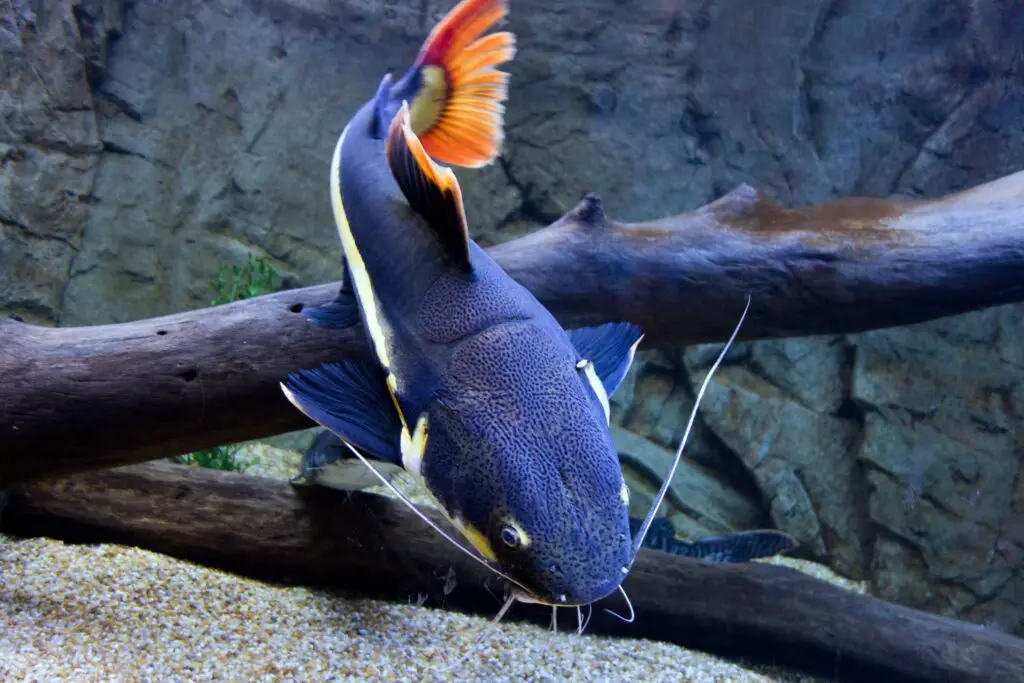
Summary of the Species
The northernmost nations of South America are home to the red-tail catfish, whose scientific name is Phractocephalus hemioliopterus. Colombia, Brazil, Peru, Venezuela, Ecuador, Guyana, and Bolivia are the nations where it is most frequently found. In search of everything it can consume, it spends its time in freshwater river basins. These fish are not picky eaters. They have a bit of a reputation in the countries they live in because of the stories people tell about how dangerous they are. The red-tail catfish is highly revered in South America. The UCN Red List of Endangered Species does not include them as an endangered species. Other names for them include Banana Catfish, Redtail Catfish, South American Red Tailed Catfish, and Flat-nosed Catfish, which are collective terms for many Pimelodidae family members.
| Information Chart | Redtail Catfish |
| Care Level | Difficult to impossible |
| Temperament | Aggressive and predatory |
| Color | Dark brown, grey with a thick yellow/white band |
| Lifespan | 15 Years |
| Size | 3-4 Feet |
| Family | Phractocephalus |
| Diet | Omnivorous |
| Minimum Tank Size | 1500-2000 gallons |
| Temperature | 70-79 ºF (21-26 ºC) |
| Water Conditions: | pH 6-7 |
| Tank Mate Compatibility | Larger non-aggressive fish |
Appearance
Color
Despite the fact that they can be brightly colored, the majority of them have a body that is a solid band of yellow or white with a thick band of dots in dark brown or grey. The dorsal and caudal fins are both red and orange in color, in addition to the tail fins. The redtail catfish is similar to other catfish species in that they both have flat underbellies. There don’t seem to be any signs that can help breeders and aquarists tell if a catfish is male or female.
Size
This catfish is a popular game fish in its natural habitat because it can grow to be five feet (1.5 meters) long and weigh up to 180 pounds (82 kg).
The Redtail Catfish’s Lifespan
Redtail catfish have generally extended lifespans. Data indicates that they can survive for roughly 15 years in captivity. Because they will have better places to live, there should be more of them in the wild. Due to their high demands, it may be challenging for hobbyists to meet those needs in their own aquariums. Its lifespan may be cut by years as a result of this aspect.
You must pay attention to the different sections below if you want to set up the best environment for these animals to thrive. For now, the phractocephalus hemiolipterus needs enough room, good food, and perfect tank conditions to live.
Predators and Prey for Redtail Catfish
The redtail catfish’s main predators are people, who often fish for it as a game fish. It is a powerful fish that frequently rules its surroundings. The redtail catfish waits for its prey to approach instead of clinging to the bottom as other catfish species do. It is a well-known voracious eater and an aggressive, vivacious predator. As aggressive defenders of their hunting sites, red-tailed catfish are territorial fish. They are good fighters and will fight any fish that tries to move into their preferred territory. During the day, it is barely moving. The creature hunts for victims at night.
Normal Behavior
Fish prefer to live alone, including redtail catfish, a bottom-dwelling species. These fish frequently display territorial violence if there are too many other fish in the aquarium, and they won’t think twice about attacking lesser species. Redtail catfish juveniles need a lot of hiding places since they are shy and need to feel secure. The majority of the time, redtail catfish are found in the bottom areas of rivers and lakes because they are slow swimmers. When awake, they hardly ever move. Even though they like to eat a lot and are aggressive, these fish are calm when they are with the right tankmates and in the right conditions.
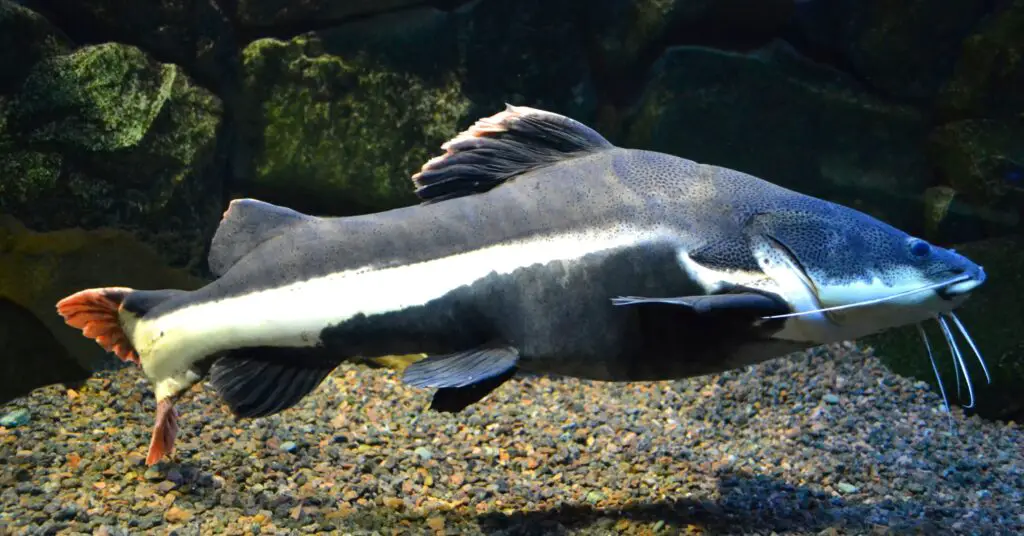
Care For Redtail Catfish and Tank Requirements
Given their size and somewhat aggressive character, redtail catfish are challenging to maintain. The fish in captivity feel more at home when their natural habitat is replicated. Feed them a varied diet and make sure food sinks to the bottom of the tank.
Requirements for Habitat and Tank
Lakes, streams, and rivers are just a few of the diverse habitats where redtail catfish can be found in the wild. Warm, relatively soft water is ideal for these fish.
Conditions in a Tank
The following tank conditions are recommended for redtail catfish:
Water Type: Freshwater, with weekly variations, makes up 30% of the total volume of the water. Due to their messy eating habits and propensity to shift substrate, redtail catfish require frequent water changes.
Tank Size: For mature fish, a tank should be at least 1,500 gallons. As the children grow older, they should be moved to larger tanks.
Water temperature: 70-79°F (21-26°C)
Substrate: None. Redtail catfish could try to eat the ground.
Tank setup: Include a few ornaments to use as hiding places
To prevent being moved or eaten, decorations should be strong and long-lasting. Ignore tiny rocks and driftwood. Any stray ornaments should be tied.
Acidity: pH 6.0–7.5
Regularly check the nitrate and ammonia levels in water and monitor the other water parameters. When the water quality is low, redtail catfish frequently surface to breathe.
Diet and Food
This fish will eat pretty much everything you feed it, so feel free to experiment, but it doesn’t necessarily imply it’s the proper thing to do. Similar to many other fish, they have specific dietary and nutritional needs that must be met if you want them to survive as long as possible. These fish will consume insects, smaller fish, worms, and any nearby plants that they come upon in their natural habitats. This should be considered when planning their nutrition while in captivity.
For a redtail catfish diet that works best, some live food recommendations are
-
- Shrimp
-
- Little fish
-
- Worm
-
- Sliced meat
Tank Mates
Redtail catfish are fiercely competitive with one another and shouldn’t be housed together. They can coexist with other species, but tank companions must be a similar size. Redtail catfish are scavengers that consume lesser fish.
Tank mates for redtail catfish include:
-
- Gars
-
- Stingrays
-
- Hefty datnoids
-
- Iridescent sharks
-
- Bichirs
Disease
Redtail catfish are tough fish, but unfavorable tank conditions might make them more vulnerable to common freshwater diseases like fin rot, flukes, and nitrite poisoning. To avoid illness, make sure the water is in good condition. Avoid putting redtail catfish in stressful situations and hold new decorations or fish in the aquarium for two weeks before introducing them. Here are a few typical ailments that affect redtail fish:
-
- Fin Rot
-
- Skin and Gill Flukes
-
- Nitrite Poisoning
The Redtail Catfish: Amazing Facts
-
- To smell, it makes use of its long, perceptive whiskers.
-
- It can get as long as six feet.
-
- It is a proactive and hostile predator, unlike other catfish.
-
- It belongs to one of the three species of enormous catfish that are native to the Amazon.
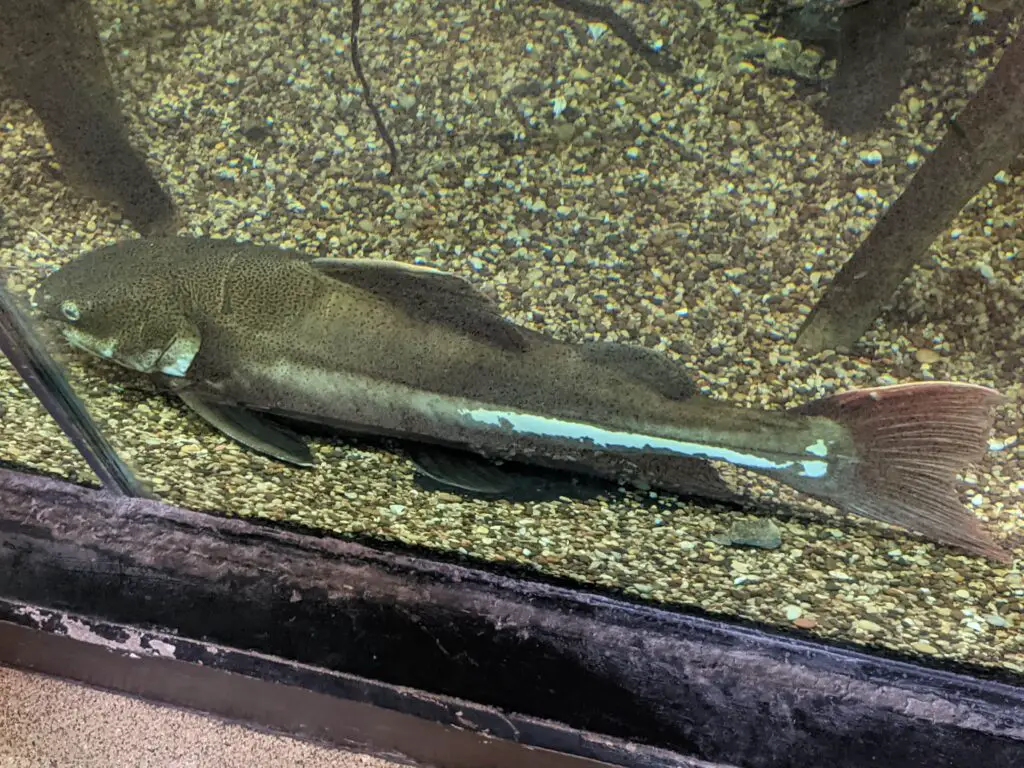
Bottom Line
-
- Redtail catfish maintenance is not for everyone, as you can likely tell. It’s not for the majority of aquariums we would say. To make it happen, you need a good amount of expertise, room, and resources.

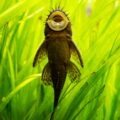
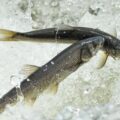









Pingback: What is the Difference Between Catfish and Whiting? | Reel Fishing Guru